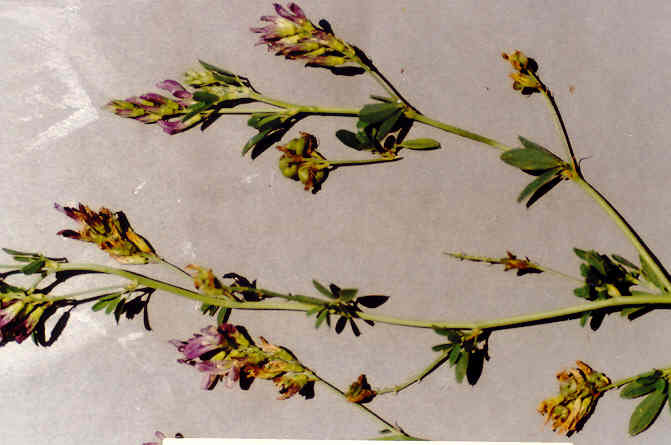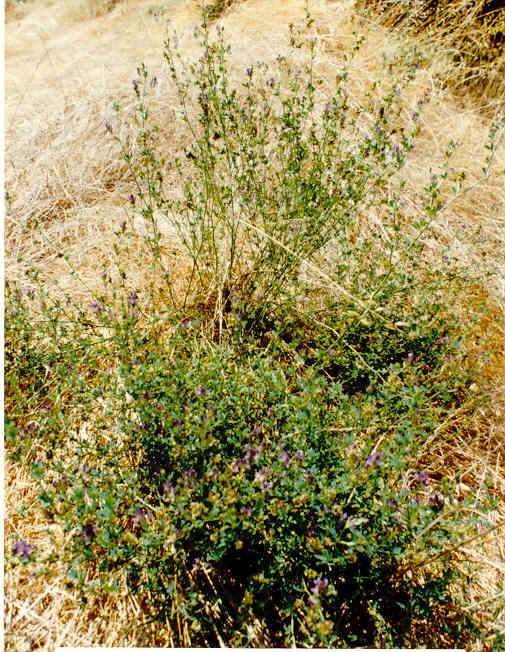
Medicago sativa L.
 |
Medicago sativa L.
Fabaceae (Pea Family)Old WorldAlfalfaChilean Clover |
July Photo
Plant Characteristics:
Erect or ascending smooth perennial from an elongate taproot,
much-branched, 4-9 dm. high; petioles 5-20 mm. long; stipules 5-8 mm. long,
entire to toothed; 3 lfts. oblanceolate to obovate, 1-2.5 cm. long, sharply
serrate at the +/-truncate tip; spike-like, 8-25 fld. longer in fr.; calyx 5-6
mm. long sparsely villous; corolla 8-12 mm. long, blue-violet to purple or
multicolored (i.e. violet, violet-green, greenish yellow, rarely yellow),
pods unarmed, coiled loosely 2-3 times, pubescent.
Habitat:
Commonly cult. and frequently established in waste places, along
roadsides, etc. April-Oct.
Name:
Greek, medice, name of alfalfa.
since it came to Greece from Medea. Sativa
means that which is sown. (Dale
115). The name Alfalfa comes from
an Arabic word meaning "father of all foods."
(Hutchens 3).
General:
Rare in the study area, having been found only once and this on the 23rd
St. bluffs. (my comment).
Brought to Calif. in 1854, it has been cultivated for more than 20
centuries. It is a bee plant and can produce 60 pounds of honey per acre.
Also, 10 tons of hay per acre can be produced. (Ref. not recorded).
Alfalfa has been cultivated for over two thousand years and is probably
the first cultivated forage plant; it was grown by the Persians, Greeks and
Romans. It was introduced early
into China and Europe and reached the United States during the colonial period.
The leaf is rich in vitamins A, K and D, minerals and protein.
It has been used to encourage the clotting of blood and in pablum for
infants, as well as a treatment for ulcers.
It is much used with Red Clover and Spearmint or Peppermint as a
substitute for pekoe tea. The
Indians of Utah ground Alfalfa seeds between stones and cooked the meal as mush
or bread. They boiled young branches for greens. (Clarke 177).
The roots of alfalfa reach down 8 or 9 feet in the soil and once
established can yield several crops a year.
(Dale 115). In
contrast to the above by Dale, Hutchens states that the organic salt of alfalfa
is among the richest known, the depth and spread of its roots enabling it to
absorb its valuable nutrition as far as 125 ft. below the earth's surface.
(Hutchens 2).
M.
sativa is still known by old-timers as an excellent tea for rheumatism,
neuralgia, any kind of ache or pain. They
dry leaves, blossoms, and stems, and make a hot brew of the dried bits. (Fielder
204). The
plant is reportedly used for arthritis. The
herb is reduced to powder and mixed with cider vinegar and honey, with one
teaspoonful of each in water. This
is considered a weight adding tonic and also strength-giving. (Kadans 149).
Not really medicinal at all, Alfalfa tea should be classed more as a
food, or at least a dietary aid. The
high mineral content of the tea, particularly calcium and trace minerals, along
with Vitamin K and Folic Acid, make it an excellent recuperative aid, as well as
a small but appreciable adjunct to the diet for chronic and functional illnesses
such as arthritis and rheumatism, colitis, ulcers, anemia, etc. It is a
traditional European and Russian tea for wasting diseases and is used in some German clinics as a dietary aid in
Celiac Disease, together with traditional treatment and diet.
(Moore, Medicinal Plants of the
Mountain West 20).
Natural toothbrushes were very popular before the use of animal bristles
or synthetic brushes. Natives of
the West Indies, Africa, and other parts of the world still use natural brushes
without additional cleansers, such as powders and pastes.
One such brush is made from alfalfa root.
Take roots of convenient size and strip off outer skin or bark, and dry
slowly. When the roots are well
dried, cut them into small pieces of 3 inch length, and upon each end thereof,
strike lightly with a hammer; the fibres are thus detached and form a brush.
(Meyer 205).
It has reached us through Mexico and Chile where it is called
"Alfalfa and Chilean Clover." In
Chile sprays of this plant are laid about in the houses to drive away fleas.
(Parsons 332). Parson's book was published in 1909.
(my comment). Legume flowers must be "tripped" to prepare for
pollination. When stimulated by a
bee, the sexual organs held down by enclosure in lateral petals suddenly spring
up ready to yield pollen and later to receive pollen from another flower.
Bees are often discouraged by the snap and impact of the anthers.
Some bees learn to trip legume flowers without being hit.
Honey bees, for example, are regularly hit as they trip alfalfa flowers
and tend to avoid visiting them. Alfalfa
seed farmers have found that native bees are more effective pollinators and they
attempt to increase their nesting sites and thereby their populations.
(Ross, Edward S. "Insect/Plant
Relationships: A Photographic Essay" FREMONTIA,
A Journal of the California Native Plant Society, April 1996 pp.
3-22). About
50 species of Eurasia and Africa; many important for hay and forage. (Munz, Flora So. Calif. 463).
Text Ref:
Hickman, Ed. 637; Munz, Calif.
Flora 831; Munz, Flora So. Calif.
463.
Photo Ref:
July 3 83 # 15,16.
Identity: by R. De Ruff.
Computer Ref: Plant Data 80.
Have plant specimen.
Last edit 1/18/03.
 |
July Photo